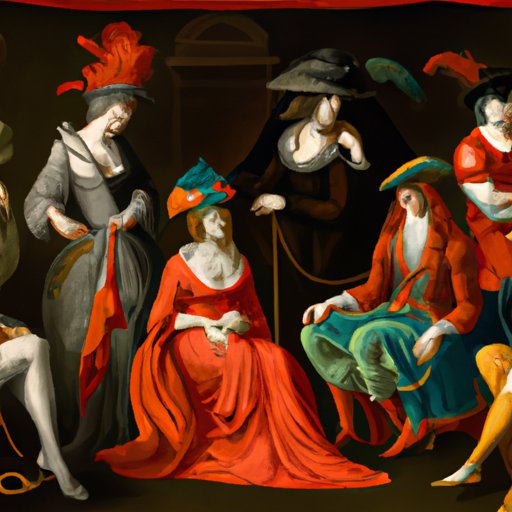I. Introduction
The Renaissance era, which took place from the 14th to the 17th century, is known as the rebirth of art, culture, and education. This period of history was characterized by great artistic and intellectual growth, and it left an indelible mark on art and culture for centuries to come.
This article aims to delve deeper into the world of Renaissance art and artists, exploring their unique styles, notable works, and contributions to the era. Whether you’re an art enthusiast or a history buff, this article will provide an in-depth understanding of the Renaissance era and its most significant players.
II. A Chronological Overview of the Major Renaissance Artists
The Renaissance era saw the emergence of some of the most influential artists in history. Beginning with the Early Renaissance, artists such as Giotto di Bondone and Fra Angelico brought new life to art with their use of perspective and naturalistic portrayal of figures.
Following the Early Renaissance, artists such as Leonardo da Vinci, Michelangelo Buonarroti, and Raphael Sanzio marked the peak of the High Renaissance with their masterpieces such as “The Last Supper” and “David”. Their works are renowned for their use of color, light, and shadow, and the intense spirituality that they exuded.
As the Renaissance progressed, the Mannerist and Northern Renaissance movements emerged, allowing artists such as El Greco and Albrecht Dürer to experiment with new forms of expression and technique.
III. Analysis of the Most Significant Art Movements of the Renaissance
The Renaissance era was marked by the development of various art movements, each characterized by its unique style and methods of expression.
The High Renaissance, which emerged in the late 15th and early 16th centuries, saw the emergence of some of the most significant artists in history. Leonardo da Vinci’s “Mona Lisa” and Michelangelo’s “Sistine Chapel Ceiling” exemplify the technical skill and beauty of this movement.
Mannerism, which emerged in the mid-16th century, saw artists such as El Greco begin to experiment with new forms of expression. This movement is characterized by elongated figures, exaggerated poses, and an emphasis on imaginative composition.
The Northern Renaissance, meanwhile, saw artists such as Albrecht Dürer and Jan van Eyck bring their unique styles to the forefront. Known for their intricate attention to detail, Northern Renaissance artists favored rich colors and a realistic depiction of the world around them.

IV. The Influence of Patrons on Renaissance Artists
During the Renaissance era, patrons played a crucial role in the development of art and culture. Patrons were wealthy individuals or institutions that financially supported artists, allowing them to pursue their work in relative ease.
One notable patron of the Renaissance era was the Medici family, who commissioned works from some of the most significant artists of the time, such as Michelangelo and Botticelli. The influence of patronage can be seen in many works of Renaissance art, as artists often worked at the behest of their supporters.
V. Comparative Study of Renaissance Art with Other Historical Periods
The Renaissance era is marked by a distinctive shift in artistic style and expression, setting it apart from other historical periods such as the Medieval or Baroque eras. While Medieval art favored a flat, stylized style of painting, the Renaissance emphasized naturalism and the use of perspective, bringing a sense of depth to the canvas.
In contrast to the Baroque era, which followed the Renaissance, the Renaissance favored a sense of harmony and balance in its art. Baroque art, on the other hand, was characterized by dramatic movement and a sense of intense emotion, marking a shift away from the balanced style of the Renaissance era.
VI. The Role of Gender and Social Identity in Renaissance Art
Diversity was not a hallmark of Renaissance art, and many artists of the era found themselves constrained by the strict societal norms of the time. However, a few notable female Renaissance artists overcame these obstacles to make a significant impact on the art world.
One such artist was Artemisia Gentileschi, who is known for her vivid depictions of powerful women. She was one of the few women artists of the era to achieve any significant success, despite facing considerable obstacles due to her gender.
VII. Critical Analysis of Famous Renaissance Pieces
Many Renaissance artworks have become iconic in the centuries since they were created, and each piece offers a fascinating insight into the minds and lives of the artists who created them.
For example, Leonardo da Vinci’s “Mona Lisa” has become one of the most famous paintings in the world, known for its enigmatic subject and stunning use of color. The painting reflects the intense spirituality and humanism of the High Renaissance era, and Leonardo’s skill as a painter is evident from the delicate brushwork and minute attention to detail.
VIII. Conclusion
The Renaissance era was a time of great artistic and intellectual growth, marked by an emphasis on naturalism, beauty, and depth. The artists of the era transformed the world of art, and their legacy can still be seen in the great works of art and architecture found in many of the world’s most iconic cities.
Whether you’re a fan of art or history, the Renaissance era offers a fascinating window into the past, and an opportunity to experience some of the most significant and beautiful works of art ever created.
(Note: Is this article not meeting your expectations? Do you have knowledge or insights to share? Unlock new opportunities and expand your reach by joining our authors team. Click Registration to join us and share your expertise with our readers.)
